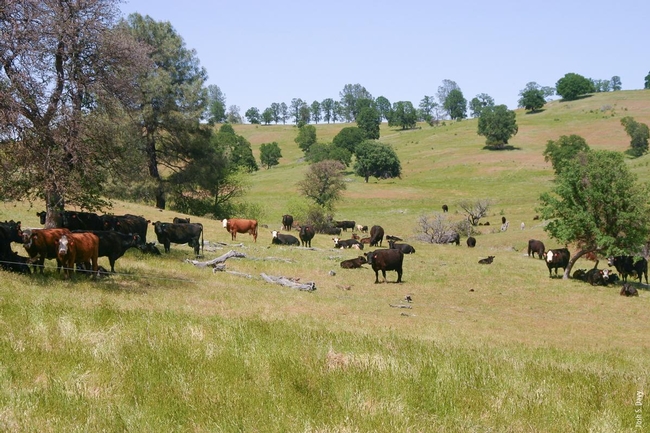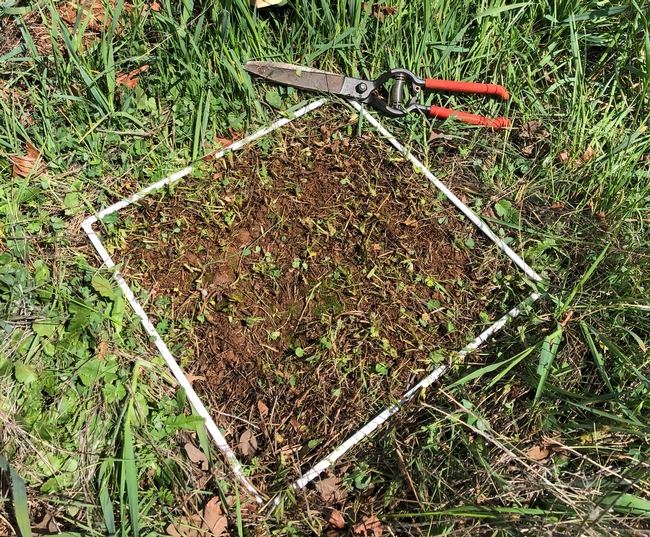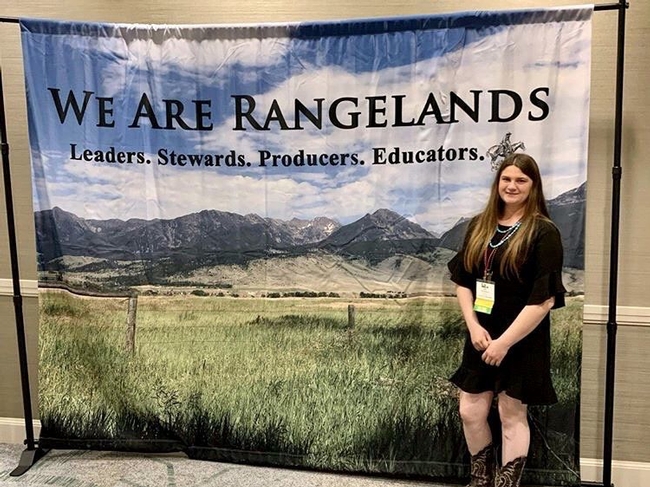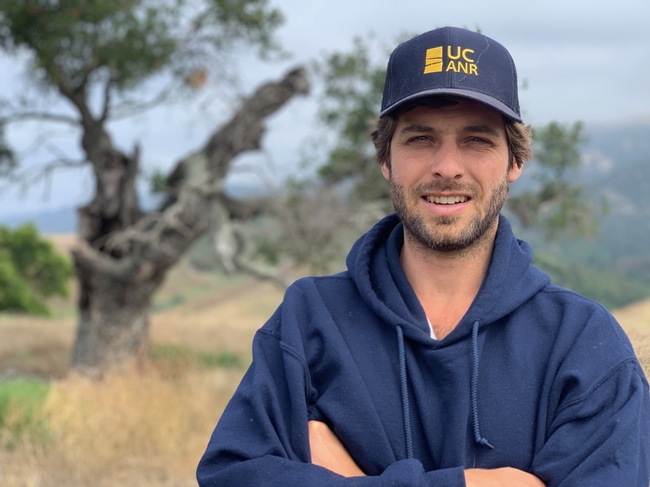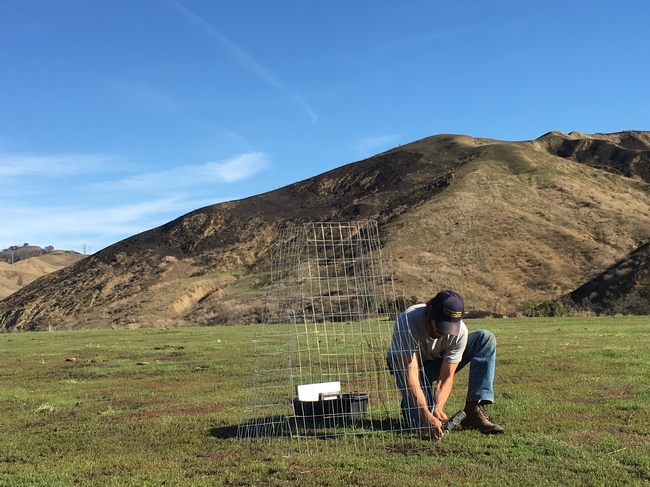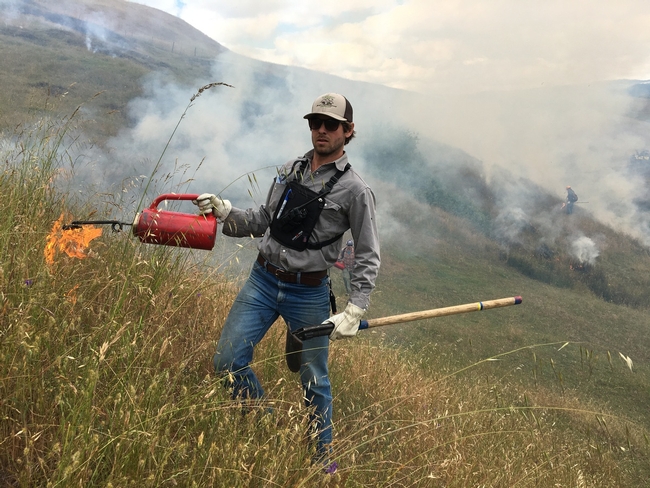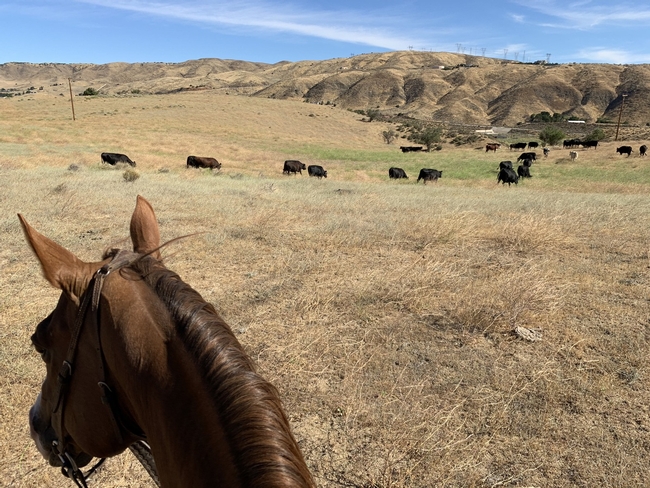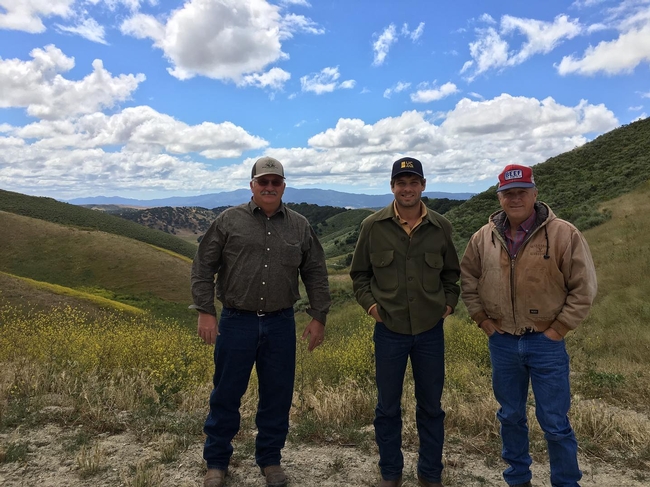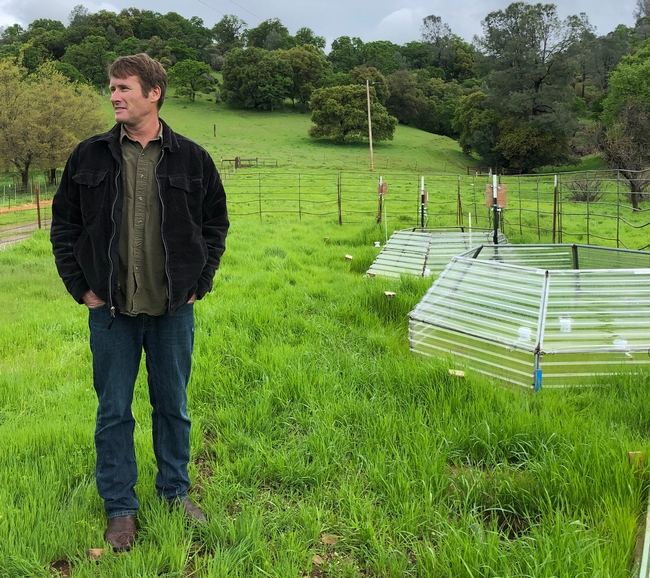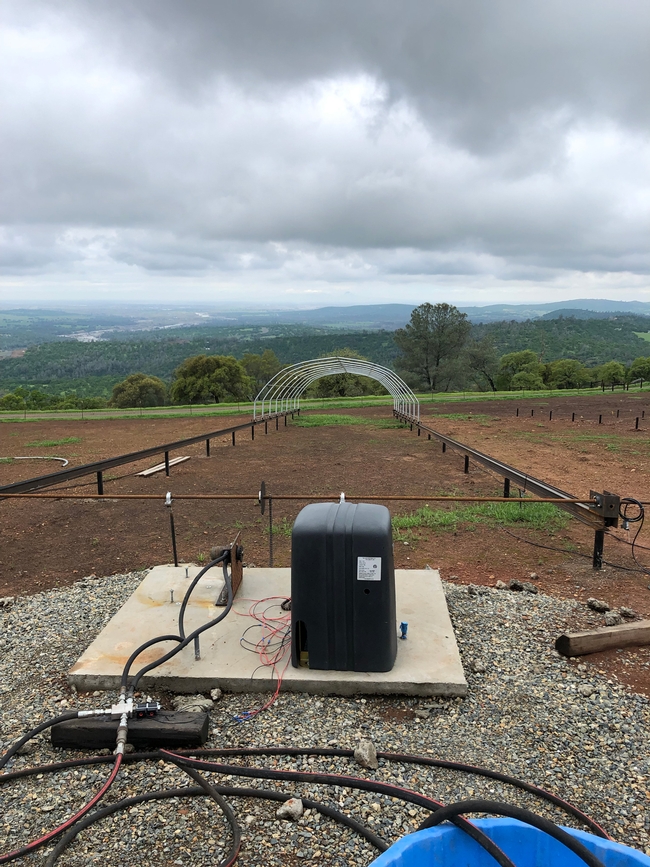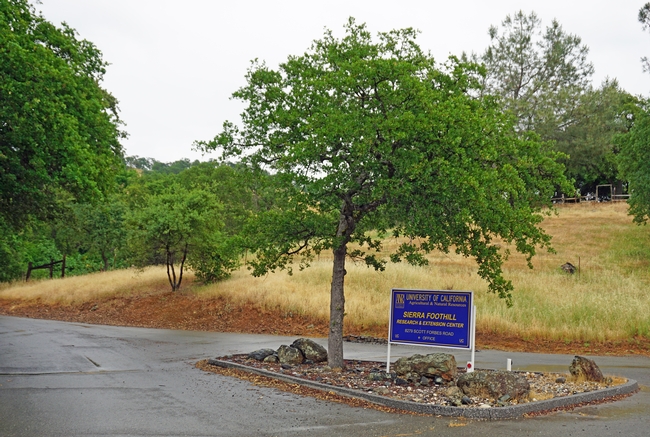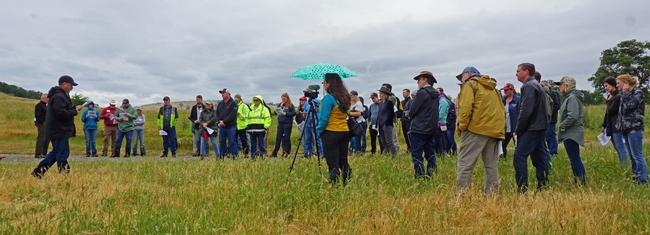Posts Tagged: rangeland
UC ANR releases new publication that synthesizes scientific knowledge on annual rangeland
Decades of research-based knowledge about the history, physical characteristics and vegetation in California annual grassland, oak-woodland and chaparral ecosystems has been consolidated in a new nine-part PDF document. The 200-page publication, The Ecology and Management of Annual Rangeland Series, is available for free download from the UC Agriculture and Natural Resources catalog.
The series includes past and current practices for managing vegetation, grazing and livestock compiled by researchers at the University of California, U.S. Department of Agriculture and other agencies and universities.
UC Cooperative Extension rangeland specialist emeritus Mel George, the lead author, said the series has been under development for 10 years. Until his retirement in 2012, George hosted an annual rangeland shortcourse, in which rangeland managers gathered for three days in Davis for presentations, field visits and printed handouts. He collected the materials and created a searchable archive of 700 rangeland publications on the UC Rangeland website, and, with a team of co-authors, summarized the most important information for the new series.
“Information on rangelands doesn't change very fast,” George said. “We have materials that are 20 years old that are still usable; even 100 years old, in a couple of cases.”
The material is broken down in the following categories:
Part 1: Mediterranean climate. The locations and characteristics that define a Mediterranean climate.
Part 2: Ecological history. California has some of the most productive croplands in the world. Recently, increasing conflicts among urban development, intensive agriculture, and protectionism have led to rigid distinctions among resource management objectives. Having a long-term perspective on the causes and interpretation of changes in the landscape can aid in resolving conflicting goals and objectives among stakeholders.
Part 3: Soils. Researchers and managers like to organize the world they live in so that they can explain their environment. This publication presents the soil taxonomy developed by soil scientists to classify soils and understand soil similarities and differences.
Part 4: History of range livestock production. Range livestock production developed as an enterprise with the colonization of California by the Spanish and their formation of ranches or ranchos, and it expanded rapidly during early statehood. The development of improved animal management and range management practices ensured that the industry would continue its dominance in California agriculture throughout the 20th century and into the 21st century.
Part 5: Range plant growth and development. The plants that dominate California's annual grasslands and the understory of the oak woodlands have different life cycles from most of the world's rangelands. This publication delves into morphological and physiological changes associated with annual and perennial life cycles, photosynthesis and carbohydrate storage, and the effect of grazing on individual plants of California's annual-dominated rangelands in the Coast Range and the foothills of the Sierra Nevada.
Part 6: Vegetation change and ecosystem services. Vegetation types in the annual rangelands include annual-dominated non-native grasslands, native-dominated grasslands, oak woodlands, chaparral and coastal scrub. The ecosystem services, or benefits, that humans obtain from each vegetation type change as the vegetation type changes. This section describes the dominant and common species in each vegetation type, the vegetation changes and change agents that are commonly recognized, and an approach to evaluating ecosystem services.
Part 7: Livestock production. Livestock production on California's annual rangelands has adapted to the seasonality of rangeland forage dominated by annual grasses and forbs growing in a Mediterranean-type climate. This part gives an overview of seasonal forage sources, nutrient requirements of grazing animals, seasonal forage quality, seasonal animal performance, supplemental feeding, water needs, livestock production systems and animal health issues.
Part 8: Grazing management. The response of vegetation, livestock and ecosystems to grazing is complex, and grazing managers are confronted with a variety of grazing strategies or systems that are sometimes hard to compare or evaluate. This part covers what are commonly known as the four components of grazing — intensity, season, frequency and duration — and their effects on annual rangelands and provides an overview of the adaptive management process of planning, implementation, and learning that grazing managers can use to help them cope with complexity and knowledge.
Part 9: Vegetation management. An overview of the research and practices for brush and weed control, seeding and fertilization. Also covered are practices that reduce seasonal gaps in forage availability and quality and the economics of vegetation management.
The Ecology and Management of Annual Rangeland Series is at https://anrcatalog.ucanr.edu/Details.aspx?itemNo=8540.
Rancher wisdom can be improved with science
When California was part of the Wild West, it took a certain amount of guesswork to move cattle from their home range to summer pastures while making sure sufficient forage was left behind to hold the cattle over till fall rainfall spurred new growth.
“Ranchers eyeballed it,” said Theresa Becchetti, UC Cooperative Extension livestock and natural resources advisor. “In time, second-, third-, and fourth-generation ranchers got pretty good at deciding, but UC Cooperative Extension introduced a more scientific approach.”
In the spring of 1936, the USDA Forest Services began measuring ungrazed forage at the San Joaquin Experimental Range in Madera County. The project continues today as a joint effort of UC Cooperative Extension and the USDA Natural Resources Conservation Service.
Sixteen years later, just after the UC Hopland Research and Extension Center was established on Mendocino County rangeland in 1951, another study began; and in the early 1980s, scientists at the UC Sierra Foothills Research and Extension Center in Browns Valley commenced a similar long-term study.
As scientists learned of the multiple factors impacting forage production across the Coast Range and Sierra Nevada foothills, some 70 research sites were identified – most on private land - and consistently monitored. The results show that there is much more to understanding forage growth than looking at a rain gauge.
|
Above, watch a full season of rangeland forage growth in one minute. UC Cooperative Extension rangeland and natural resources advisor Royce Larsen set up a camera to capture images of the daily grass growth on Pozo Peak in San Luis Obispo County. |
While high annual rainfall usually results in high forage production and low annual rainfall generally results in low annual production, there are exceptions. It all depends on the timing of the rainfall.
During the devastating drought of 2011-2016, Becchetti noticed forage production didn't mirror the drought damage to state water resources and mountain forests.
“It was interesting,” said Becchetti. “In a lot of my plots, forage would be close to normal. We got rain when the soil was warming up. If we get rain in the late fall or winter, there is no grass production because it's too cool. If rains come when the temperatures warmed up, the grass takes off.”
The expected variation from climate change is another factor that encourages UCCE scientists to conduct routine forage monitoring.
“When I started 11 years ago, we had some good production years; we had poor years, a couple of normal years,” Becchetti said. “Monitoring is giving us a better snapshot that all of us can use to see the impact of climate change on forage production.”
To develop an accurate picture of forage growth, the research locations are fenced or caged to keep out grazing animals. Grass and forbs within one square foot of the exclosure is clipped to the ground. The vegetation is dried, weighed and the figures logged in a database.
Long-term production data are particularly valuable for the three research stations because daily weather data that are also collected there can be used to determine the effects of rainfall and temperature on annual forage productivity.
Year-to-year variability at the Hopland research site ranged from 900 pounds of forage per acre in the poorest year, up to a 3,500 pounds per acre bounty when conditions were just right. Average annual production at Hopland is 2,399 pounds per acre. At the Sierra Foothill Research and Extension Center, annual forage ranged from a low of 1,071 per acre up to 4,696 pounds per acre. The average annual production there is 2,971 per acre.
“There is no way we could represent the exact forage production across the state, but this does allow us to come up with a percent either below or above normal for a particular area,” Becchetti said.
The monitoring research conducted by UCCE scientists are important to provide guidance to county agricultural commissioners and local Farm Service Agencies.
“If you think about it, so many of our ag commodities are based on weight or volume,” said Scott Oneto, UCCE rangeland and natural resources advisor in El Dorado, Tuolumne, Calaveras and Amador counties, where annual monitoring has been conducted for 25 years. “But annual rangelands are so different when it comes to figuring out whether a given year is average, above average or below average. And when crop insurance is involved, it makes it very difficult for ag commissioners to declare a loss if they don't know what the loss is or if there even was one.”
Becchetti, along with 14 current and former UCCE colleagues, wrote a 12-page review of UCCE's ongoing range forage production study, which includes average production for many of the study sites. ANR Publication 8018 is available for free download from the UC ANR publication catalog.
Santa Ynez teen represents California at rangeland youth forum
A 16-year-old high school student and sixth generation Santa Ynez Valley rancher Lily Masopust traveled to Denver for the Society for Range Management's annual High School Youth Forum Feb. 16-20, reported the Santa Ynez Valley News.
The youth forum was founded in 1966 to introduce young people to rangeland conservation. Masopust was awarded the opportunity to participate when she attended Range and Natural Resources Camp at the UC Cooperative Extension Elkus Ranch Environmental Education Center in Half Moon Bay last summer.
At the end of camp, the participants were quizzed on their learned knowledge and the top three were invited to represent the California-Pacific section of the Society for Range Management at the Denver event. Masopust also received support from the Santa Barbara County Cattlewomen's organization.
Each of the forum delegates prepared and shared a formal presentation on a range-related topic. Masopust reported on foothill abortion, a disease caused by a bacterium from the Pajoroella tick which affects cattle in California, Mexico, Nevada and Oregon. She chose the topic because the condition is causing economic losses on her family's ranch. A vaccine has been developed, however currently lacks pharmaceutical backing.
Shapero protecting California’s natural resources
Rose Hayden-Smith, UC Cooperative Extension digital communications in food systems & extension educator, talked with Matthew Shapero about his work protecting California's natural resources. This is the second in a series featuring a few scientists whose work exemplifies UC ANR's public value for California.
Matthew Shapero is originally from California and has worked as an ANR Cooperative Extension livestock and range advisor since September 2017, based in Santa Barbara and Ventura counties. Matthew attended Columbia University and completed a Master of Science in range management from UC Berkeley. Prior to joining ANR, he farmed on the East Coast and in Nevada County, where he ran a ranch. His current research and Extension program focuses on several issues, including prescribed fire and how to prepare for and respond to wildfire. You can follow Matthew on Facebook and Instagram.
Tell us about your current research and Extension projects
I could certainly use the old ranching metaphor: “Way too many irons in the fire.” As a beginning advisor, one says “yes” to things that seem interesting and have promise, but projects develop in their own time. I'm currently working a great deal on wildfire issues, including prescribed fire and fire recovery. There's a need for long-term research to look at the effects of grazing as part of post-fire recovery. I am working with five ranches that experienced fire, and considering how land managers and agencies might be thinking about grazing and post wildfire recovery.
I'm also doing some research on soil seed bank, with a focus on how fire intensity impacts rangeland seed bank. [Editor's Note: “Soil seed bank” refers to the natural storage of seeds – often dormant – within the soil of ecosystems.]
Has thinking evolved on prescribed fire?
It has. I received an M.S. degree in range management from UC Berkeley. The program didn't cover much of the research and practices around prescribed fire, because it seemed to be an unrealistic land management tool in today's day and age. The Thomas fire occurred in December 2017, just three months after I started my work as a Cooperative Extension advisor. I've seen the political winds shift since then; prescribed fire has become much more palatable in this area since Thomas, as a technique to proactively deal with the threat of catastrophic wildfire.
There's a relatively short window (a couple of months annually) where the conditions and circumstances are aligned for prescribed burning. In Fall 2018, I was involved in a prescribed burn of 380 acres using a type of private burn permitting that hadn't been used in a long time. As a Cooperative Extension advisor, I played a relatively important role in connecting the dots and helping that burn get up and off the ground. Part of my work is nudging people, following up, connecting people. I think my work is a good example of how a Cooperative Extension advisor inserts himself/herself into the process. With ranchers, private landowners, county fire agencies and others involved, there is a need for good communication.
In the aftermath of that burn, I organized an event for elected officials, agency heads, and other decision makers to visit the prescribed burn site. It was helpful for them.
My program covers Ventura and Santa Barbara counties, which have different histories with prescribed fire. Santa Barbara County has had a strong range improvement association from the 1950s through the present, which conducted prescribed burns at a significant rate up through the 1990s. For example, between 1955 and 1964, this association burned over 100,000 acres in private land, with little assistance from the county fire department.
This is in contrast to Ventura County, which has less of a surviving rancher-led burn culture. While producers burned within the county, there is no formal existing organization that plans and executes burns. I've been helping to revive burn culture in Santa Barbara County, but there's been less to draw on in Ventura County. Both have county fire agencies instead of CalFIRE. They are supportive of private-led burning, but to actually implement prescribed burns is easier in Santa Barbara County than in Ventura County. Ranchers and private landowners in Santa Barbara are more comfortable with fire, and many have some of the resources required (water tending trucks, drip torches, flamethrowers, etc.). We're building momentum, though, and the conversation has shifted since the Thomas Fire.
Did the Thomas Fire change perceptions about the value of ranchland in Southern California?
The Thomas Fire demonstrated that even if you live in a city or suburb, the way natural resources are managed impacts you. Livestock production is not an agricultural sector that generates a lot of gross revenue (it barely registers in the list of top 10 crops by revenue in each county), but it has great spatial impact. How it is managed impacts water quality, wildlife habitat, and the view those living on the peri-urban interface enjoy. There is important public and economic value in the way rangelands are managed.
What are the challenges facing the ranching industry in Southern California?
The challenges the ranching industry faces in Southern California aren't necessarily new. I recently came across an Extension research bulletin published in 1972 that explained how Santa Barbara County was trialing new nitrogen fertilizer on rangeland. My predecessors identified “rising taxes and land scarcity” as challenges facing ranchers, and these things would still hold true.
These challenges are not unique in California, but the impact may feel different here. The Southern California counties in particular have a long and deep ranching history that was defined in many ways by Spanish ranchos.
The industry is potentially at a critical breaking point, though. It's not just land, but the lack of supporting infrastructure. For example, it's much more difficult to get cattle trucks down here; the nearest approved USDA slaughter house is hours away, and the nearest sale yard is in Kern or Monterey County. In Santa Barbara County, there is increasing pressure for land conversion and land use change. Many individuals are interested in creating vineyards and estates, which is breaking up and making into smaller parcels larger ranches, so that they can no longer be run profitably as livestock operations.
In an optimistic sense, there has been a shift in public opinion over the last 20 years about ranching. At one time, ranching was vilified as being harmful to land, especially public lands. The Bay Area has had more sophisticated conversations about how ranching and environmentalism can co-exist, and what the co-benefits are.
There is every reason to think that the conversation around ranching will mature and become more nuanced in Southern California as well. Topics such as water quality and endangered species - which seemed like flashpoints and a source of friction – have given way to discussions that identify areas of co-benefit. Ranchers do so much for wildlife in keeping rangelands open and undeveloped. But they are often targeted with what they regard as unfair legislation around fencing and vegetation removal. Urban public opinion should recognize the value of keeping ranchers on the land.
Why are you working for Cooperative Extension?
I'm interested in the public value aspects of the work. Traditionally, Cooperative Extension measured the impact of our work by the increase of forage grown per acre, or the number of pounds of beef extracted from a ranch. While those things are important, I see our role expanding. In addition to increasing agricultural production, my work is also about the potential to engage on policy and on a cultural level.
Livestock advisors throughout the state are an important point of nexus in terms of communicating the value of ecosystems management. We are often the connection between the broader general public and an agricultural constituency. I spend a lot of my time translating how and why ranching benefits the general public, why cattle might be good for the planet (not bad), and why cattle have ecosystem benefits for rangelands. I find as much as my work is increasing and improving herd health, it is also lubricating public policy discussions, and providing analysis that has benefits for ranchers and the general public.
Extension grounds positions in science and through neutrality. There is an important role for Extension in facilitating the conversations that identify mutual benefits.
UC ANR research to determine future climate change impacts today
Scientific evidence of a warming climate in California and across the globe is clear, but the impacts on ecosystems and agriculture are still difficult to predict.
Sophisticated computer models are used to forecast future climate. Understanding that temperature and precipitation levels will change in the future does not tell the full story: UC Agriculture and Natural Resources researchers also want real-world experience under those future conditions.
Moreover, some agricultural operations have higher sensitivity to the changes than others. Rangeland forage is particularly sensitive to climate changes since, unlike irrigated agriculture, ranchers rely solely on precipitation. They have no control over how much and when it rains.
“It's tricky business,” said rangeland expert Jeremy James, the director of the UC Sierra Foothill Research and Extension Center in Browns Valley. “It's not easy to forecast. We have to address the uncertainty in a realistic manner.”
Discovering climate change impact on rangeland
In order to study different climate projections on rangeland, James and Maggi Kelly, director of the UC ANR Informatics and Global Information Systems special program, have begun development of a research site that will allow scientists to manipulate the temperature and rainfall on sections of rangeland to understand what would happen under predicted weather scenarios.
With a $220,000 National Science Foundation grant, construction is now underway on a four-acre site at the research center that will help scientists learn how temperature and precipitation will impact growth and diversity of forage that ranchers use to raise their livestock.
“We need to know how rangelands will respond when conditions change,” James said. “Will we grow more, but dry out earlier? Will we have more medusahead (an undesirable rangeland weed) or more soft chess (a high quality forage)?”
When complete, 16 shelters on steel tracks will be connected to computer systems and hydraulic motors to move them up or down a research plot. The shelters and other equipment will allow scientists to precisely control the amount of precipitation (or irrigation water) that rains onto the plot. Other systems will give researchers control of air temperature.
“This facility isn't designed for one type of research,” James said. “It is designed to conduct a wide variety of research by scientists over the next several decades. With this setup, we can look at the effect of climate change on soil biological communities, soil carbon, insect communities, plant-insect interactions and oak seedling recruitment.”
The research results from the project should provide ranchers and land managers a better understanding of how climate change may impact agriculture and ecosystem function on rangeland while also providing important information on how to minimize impacts of these changes.
Some aspects of the research facility's development are not covered with funding from the National Science Foundation. The scientists are looking for additional support to complete the project.
For more information, contact James at jjjames@ucanr.edu.
Current work underway at the Sierra Foothill Research and Extension Center
The Sierra Foothill REC, a 5,000-acre facility on the Yuba River, has supported research, education and outreach in the Sierra foothills since 1960. Multiple lines of research are being conducted at SFREC. During a recent workshop, scientists from UC Davis, UC Berkeley and UC Cooperative Extension shared a sampling of their work at SFREC.
UCCE livestock and natural resources advisor Dan Macon described a project aimed at helping ranchers make decisions about maintaining a cattle herd when faced with impending drought. Ranchers are reluctant to sell off their cattle even when the near future weather forecast is dire.
“Science tells us you shouldn't feed your way out of a drought,” Macon said. “But you want everything to stay the same. You want to maintain your genetic potential and keep cows that are familiar with the area.”
Working with ranchers, the research project will compare management practices to determine the best way forward when the future looks meteorologically bleak.
“We're assigning cows to a traditional weaning and early weaning groups,” Macon said. “They'll be out on the range from March to early September under different parameters. We're also tying in economics, the value of genetic potential and the value of having cows who know the landscape.”
Research by University of Oregon post doctorate researcher Ashley Shaw is looking into whether compost applied to rangeland will help mitigate climate change by sequestering more carbon, and also benefit forage under drought by increasing the soil's water-holding capacity and improving nutrient delivery.
Preliminary results are promising. A single application of 1/4-inch of compost resulted in forage production that was higher than areas where no amendment was applied and areas that were treated with a chemical fertilizer.
“The biggest impact was under drought shelters,” said Shaw, referring to PVC frames that were covered with plastic during rain events to understand the impact of the treatment under dry conditions. “In the drought plots, the areas where compost was applied are staying green longer.”
A defining research tool at SFREC is a dataset that includes information on monthly rainfall and forage production going back 40 years.
A review of the data shows surprising variations and correlations at the center, where forage production averages 3,000 pounds per acre, but ranges from about 1,000 pounds per acre in 1987, to over 5,000 pounds per acre in 2018, when there was so much growth, “we didn't have enough animals to graze,” James said.
The dataset paints a spectrum of the variation that ranchers across the state must navigate to manage their livestock and rangeland in a way that is profitable and ecologically sound. Research at the Sierra Foothill REC offers invaluable information to help them better understand the ecosystem and make informed decisions.

